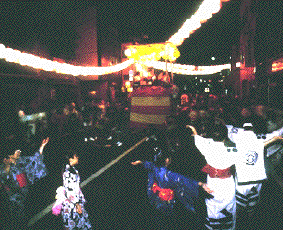 (Photos: Kyodo)
(Photos: Kyodo)OBON:
Japan's Virtual Summer Holiday
AUGUST 14, 1996
 (Photos: Kyodo)
(Photos: Kyodo)
Various midsummer events are held in Japan to console the spirits of ancestors. According to Buddhist teachings, which were introduced into Japan from India via China, the souls of ancestors and the deceased return to their families for four days in mid-July (by the old calendar). By custom, households welcome the spirits home, placing offerings on the family Buddhist altar and visiting graves. Today, by the modern calender, these customs are practiced in most areas from August 13 to 16, a period known as Obon. The period before and after Obon is virtually Japan's summer holiday. While schools go on holiday from mid-July through to the end of August, most stores take just a few days off on both sides of Obon. A Ministry of Labor survey of 1,330 companies with 30 or more employees reveals that around 85% of companies will schedule their summer vacation again this year to cover the Obon period in mid-August. The most common length of holidays, given by 20% of companies, is 9 days, with 16 days the longest. The average length of 8.1 days vacation is up 0.5 days over last year.
 Homeward Bound
Homeward Bound
Many people who now reside in the large cities but have their roots in the provinces return home en masse during the Obon season. In recent years people have tended to stagger the timing of their trips to avoid a rush, but nevertheless trains and airplanes are always fully booked for both going and coming back, and the congestion on expressways is always hideous.
Back home a busy round of activities awaits the travelers, including setting afloat lanterns (to see off the spirits of ancestors) and traditional dancing. Colorful fireworks displays also illuminate the night skies here and there. In contrast, the central areas of Tokyo and other large cities are quiet for a change at this time of year, and commuter trains run almost empty.
Overseas Bound
The summer holidays, centered around Obon, are also a season for travel. One major travel agency predicts that the number of travelers during July and August this year will reach 80.45 million, including those returning home to their families. This means that no less than two out of every three Japanese will be traveling, including babies and the elderly. The number of overseas travelers is expected to increase by about 8.3% over last year to 3.33 million.